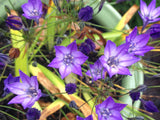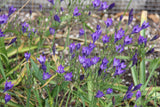Triteleia laxa, Ithuriel's Spear
These luscious, bright deep blue-purple flowers, members of the lily family, are easy to grow, thriving in either sandy loam, gravelly loam, or clay. They stand from 4" to 15" tall, depending on the soil in which they are grown and their exposure. Also called "Indian potatoes," the corms were a staple food of our indigenous peoples.
Packets contain 7-9 bulbs, approximately 1 oz.
Culture: PLANT BULBS 2-4" DEEP in the late summer and early fall. PLANT 2-4" APART. Sprouts will appear above the soil in late fall and winter. Irrigate if the rains are spotty or late to keep the leaves and flowering stalk growing.
Native bulbs and corms grow well in boxes with stainless steel wire on the bottom to protect the corms from gophers. Ceramic containers at least one foot deep, preferably deeper, are another great way to increase the population. In wetter areas, the gardener may find that seasonal flooding holds down the gopher population. Some areas still have gophers controlled by predators. In limited numbers, gophers actually spread Indian potatoes.
Native bulbs (will use this term to mean both corms and bulbs) are part of California's grassland and meadow species and can be incorporated into your "mini-meadow."
At harvest time, wait till the seeds have ripened and follow the seed stalk into the ground to find and remove the mother corm at the bottom, which should have a number of cormlets clinging to its sides. Gently detach the cormlets and replant them in the loosened soil for next year's harvest. If you are interested in tasting this staple of indigenous tribes, you can prepare the mother corm by removing the hairy overcoat. Then either boil for about 15 minutes or bake at 350 for 10 minutes. You can also boil it and then sauté it in hot oil. Eat with salt and pepper. The longer they cook the sweeter they become.
You can also store the mother corms till it is time to plant them with the fall rains. Kids love to find the mature bulbs and corms with the babies clinging to them, which will make new plants that come into their flowering time more quickly than is possible by seed.
One packet contains 9 bulbs




